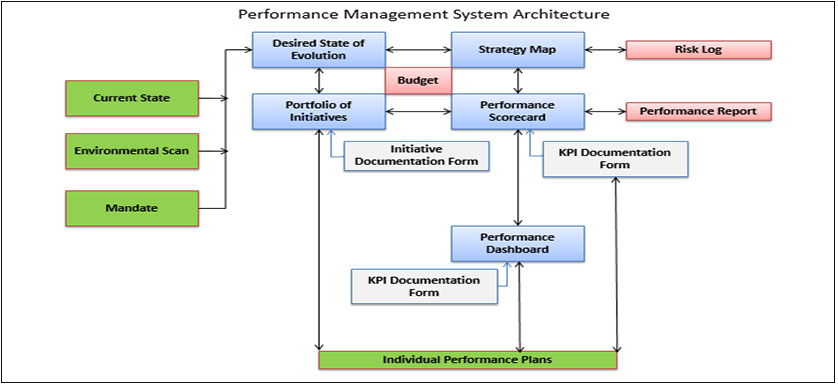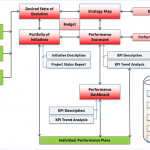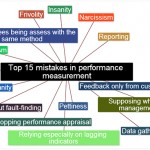Understanding the Performance Management System
Performance management systems are often associated with the urge to control and penalize underperformance. Despite the general employee perception regarding this matter, the main roles of performance management systems are totally different:
- Facilitating strategy implementation;
- Ensuring alignment of resources and activities;
- Focusing on what matters the most for the organization;
- Measuring performance;
- Providing feedback and opportunities to improve.
Mapping the performance management system will enable managers to better understand the tools they are using and how they interact and generate the system’s dynamics.
Main tools
This is an example of a high level performance management architecture, provided by The KPI Institute.
The first prerequisite for establishing a performance management system is to clarify the strategy by analyzing the organization’s current state and its external environment. The mandate represents a validation, coming from top management, to support the implementation process. The strategy plan should be translated into clear, actionable short and long term objectives.
The Desired State of Evolution communicates where the company wants to be in 3 or 5 years, in terms of clear, desired result levels. The strategy map also translates strategy into actions by presenting objectives and interconnections between them. These objectives are further detailed in the Performance Scorecard, where each of them has at least one key performance indicator (KPI) assigned. KPIs are used to monitor the progress done in achieving that specific objective.
The Portfolio of Initiatives, consisting in all organizational projects, should be aligned to the Desired State of Evolution, as they are the levers for strategic achievement. Initiatives should not receive approval unless they support the strategic plan.
The performance dashboard provides visibility to daily operations and enables managers to take timely actions at departmental level.
At employee level, each individual performance plan contributes to achieving the organizational strategy. The individual performance plans can consist in an individual scorecard, a competency and a behavior framework.
Main processes
Some of the most important processes that take place within the performance management system are:
- KPI selection and KPI design;
- KPI measurement;
- Data gathering for KPIs;
- KPI reporting.
In addition, there is a constant feed-forward and feedback process that provides the necessary information for the system to adapt to changes and function properly. This constant provision of information also facilitates the organizational learning process.
Governance
The Performance Management System should be designed and managed by a Strategy or Performance Office. Whether there is an entire team or just one person in the department, accountability is important for an efficient system management. Responsibilities of the Performance Architect or Strategy Managers include:
- Coordinating the KPI implementation project;
- Designing the framework and all instruments used;
- Providing training and awareness sessions for all stakeholders involved, like KPI owners and data custodians, to better understand the system;
- Providing support to KPI owners and data custodians;
- Facilitating the organizational performance review meetings;
- Maintaining an updated performance management system;
- Facilitating strategic planning and strategy review;
The main purpose of a performance management system is not to control, but to provide a framework for implementing strategy, measuring progress and improving performance.
References:
- The KPI Institute (2014), Certified KPI Professional Training Course
- The KPI Institute (2014), HR Performance Management System Toolkit
Image source:

Tags: Performance Management, Performance Management Architecture, Performance Measurement







